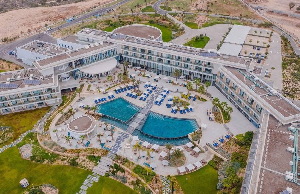Palm oil plantations have already destroyed huge swaths of orangutan habitat in Indonesia. Now the same thing is happening in Africa, where large-scale industrial plantations threaten chimpanzees, gorillas, and mandrills, among other species.
According to a new report from Greenpeace Africa, rubber and palm oil plantations have grown rapidly in southern Cameroon since the beginning of the decade. The organization collected satellite images that show rapid deforestation in an important area of jungle habitat abutting the Dja Faunal Reserve, a UNESCO World Heritage Site that is home to more than a dozen endangered primate species, as well as elephants, leopards, and the nearly extinct African gray parrot.
“We can see a clear increase of palm oil investments in tropical Africa in the past years,” said Filip Verbelen, a senior forest campaigner for Greenpeace. “Several of the new palm oil projects that are popping up will have—or already have—a negative impact on the tropical rainforest.”
He said many regions being developed or prospected for development in various countries include critical portions of the ranges for western lowland gorillas and bonobos as well as multiple chimpanzee subspecies.
The deforestation documented by Greenpeace occurred on a land concession called Hevea Sud, where companies from China and Singapore operate rubber and palm oil plantations. As seen in the satellite images, the deforestation there appears to extend to the Dja Faunal Reserve’s borders.
According to Greenpeace, concessions are planned for the currently intact, dense rainforests near other reserves, including the proposed 547-square-mile Ebo Wildlife Reserve. Verbelen called Ebo “one of the top-priority areas for primate conservation in Cameroon.”
Even though the deforestation is taking place outside protected reserves, Greenpeace contends that it is still important habitat. Meanwhile, industrial development next to reserves can prevent species migration, change water patterns, create erosion, and pose other threats to plants and wildlife.
“Large-scale industrial projects so close to protected areas often causes irreversible damage,” said Verbelen. “One would hope that the zones surrounding those protected areas are allocated for some ‘softer’ form of land use such as community forestry or local agriculture.”
A July 2014 UNESCO report also indicates that poaching is on the rise in the Dja Faunal Reserve. Verbelen said development next to reserves provides poachers with easy access to areas that humans previously rarely visited.
“The project will contribute to a significant increase of poaching inside and outside the reserve,” he said.
The reserve faced almost no hunting pressure when it was listed as a World Heritage Site in 1987. Commercial hunting is banned within the reserve’s borders, except by a small community of Baka Pygmies who live there.
Greenpeace said the deforestation in Hevea Sud, although it totals only about 11.5 square miles so far, should be considered a warning of things to come.
“Protected areas are under increasing pressure pretty much everywhere in the tropics,” Verbelen said. “There is an explosion of new development projects in the Congo Basin, notably mining, oil, infrastructure and agro-industry such as palm oil. These projects will have major direct and indirect environmental and social impacts, with large areas of pristine tropical rainforest permanently destroyed and large numbers of rural communities affected. The impact on wildlife and forest ecology cannot be underestimated.”
Actualités of Wednesday, 25 February 2015
Source: TakePart













